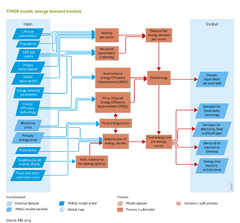Energy demand/Policy issues: Difference between revisions
Jump to navigation
Jump to search
No edit summary |
No edit summary |
||
| Line 1: | Line 1: | ||
{{ComponentPolicyIssueTemplate | {{ComponentPolicyIssueTemplate | ||
|Reference=Van den Berg et al., 2011; | |Reference=Van den Berg et al., 2011; | ||
|Description=The model shows that under a typical baseline scenario such as the one of the Rio+20 study, energy demand is projected to grow significantly during the 21st century. Most growth will be driven by an increase in energy use in low-income countries. Per capita use in high-income countries is projected to remain more or less constant, consistent with recent historical trends. The increase in energy demand in the first half of the century will be mostly met by fossil fuels and electricity. In this model simulation, hydrogen becomes competitive in the transport sector in the second half of the century, as a result of increasing oil prices and the assumed progress in hydrogen technologies. An alternative assumption could result in a similar role for electricity. | |Description=The model shows that under a typical baseline scenario such as the one of the [[Roads from Rio+20 (2012) project|Rio+20]] study, energy demand is projected to grow significantly during the 21st century. Most growth will be driven by an increase in energy use in low-income countries. Per capita use in high-income countries is projected to remain more or less constant, consistent with recent historical trends. The increase in energy demand in the first half of the century will be mostly met by fossil fuels and electricity. In this model simulation, hydrogen becomes competitive in the transport sector in the second half of the century, as a result of increasing oil prices and the assumed progress in hydrogen technologies. An alternative assumption could result in a similar role for electricity. | ||
|Example=The PBL study Resource Efficiency ([[Van den Berg et al., 2011]]) provides an example of how TIMER can be used to explore the impact of radically improving energy efficiency. The study included an accelerated trend to best available technologies in iron and steel production and other industries, most efficient passenger vehicles and aircraft, a moderate shift from aircraft to high-speed trains, and building highly efficient housing (mostly insulation measures). The study also assumed that newly installed power plants will be based on the best available technologies. The measures in this global energy efficiency scenario will considerably reduce energy use than under the baseline scenario. Primary energy consumption will be reduced by about 30% by 2050. | |Example=Various policy interventions can be implemented in the energy demand submodules in different ways: | ||
* Energy tax and carbon tax. This changes the prices for the energy carriers influences the choice of technology. | |||
* Discount rate/payback time. In the residential submodule , the perceived costs of capital (discount rate) influence the extent of energy efficiency improvement (PIEEI) and the choice of fuel and/or technology in the residential submodule. | |||
* Preferences. Fuel choice can be influenced by correction factors, representing aspects that influence fuel choice but are not incorporated in the price, such as fuel characteristics (e.g., cleanliness, availability), comfort and speed considerations, and infrastructure. | |||
* Efficiency standards. Such improvements can be introduced for the submodules that focus on specific technologies, for example, in transport, heavy industry and households. | |||
* Enforced market shares of fuel types. Such an analysis could, for instance, provide insight into the implications in the model of increasing the use of biofuels, electricity or hydrogen ([[Van Ruijven et al., 2007]]). | |||
The PBL study Resource Efficiency ([[Van den Berg et al., 2011]]) provides an example of how TIMER can be used to explore the impact of radically improving energy efficiency. The study included an accelerated trend to best available technologies in iron and steel production and other industries, most efficient passenger vehicles and aircraft, a moderate shift from aircraft to high-speed trains, and building highly efficient housing (mostly insulation measures). The study also assumed that newly installed power plants will be based on the best available technologies. The measures in this global energy efficiency scenario will considerably reduce energy use than under the baseline scenario. Primary energy consumption will be reduced by about 30% by 2050. | |||
}} | }} | ||
Revision as of 15:31, 22 May 2014
Parts of Energy demand/Policy issues
| Component is implemented in: |
|
| Related IMAGE components |
| Projects/Applications |
| Key publications |
| References |
